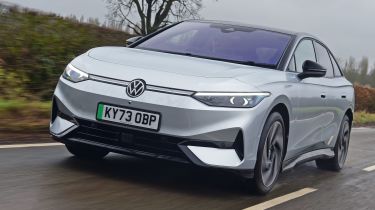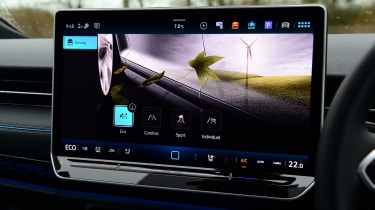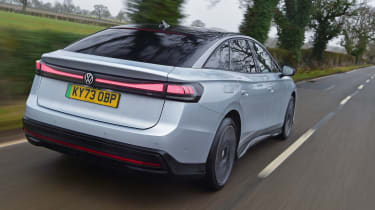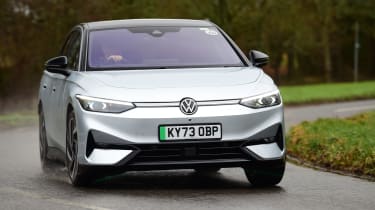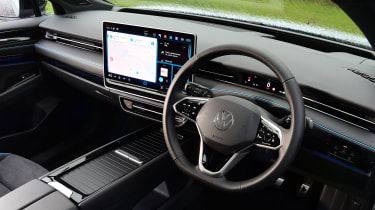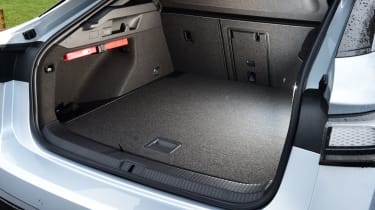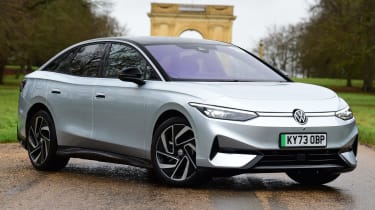Volkswagen ID.7 review: the posh people’s car
Volkswagen has almost nailed the brief of the electric saloon, with only a small handful of foibles keeping the ID.7 from the top of the class
Pros
- Competitive range and charging
- Good to drive
- Spacious
Cons
- Pretty expensive
- Drab interior
- Fiddly controls
Volkswagen ID.7 verdict
The Volkswagen ID.7 is far from the German giant’s first electric car, but we think it’s certainly its most complete model yet. While we wait for the 400-mile flagship to arrive, we can say that even base Pro models offer a strong – if perhaps a tad optimistic – range figure, as well as a comfortable ride and a surprisingly solid driving experience. Volkswagen has largely ironed out many of the problems that we have with its infotainment system, although some fiddly touch-sensitive controls remain. As posh and practical as a blazer paired with cargo trousers, the ID.7 will be a hit with business drivers. Private buyers may be put off by its lofty price, though.
Details, specs and alternatives
Comfortable, spacious and economical, the Volkswagen Passat was once the de facto car choice for business and fleet drivers alike. Nowadays, however, electric cars like the Tesla Model 3 and Polestar 2 are stealing the spotlight thanks to their low Benefit-in-Kind ratings. With this in mind, VW is hoping to steal the company car crown once again with its latest model, the ID.7.
Measuring almost five metres in length, the Volkswagen ID.7 is actually closer in size to large electric executive cars like the Mercedes EQE and BMW i5, as opposed to Beemer’s own i4 of which is more in line with the VW on price. Acres of smooth, clean bodywork gives the ID.7 a drag coefficient of just 0.23Cd, which puts it amongst the most aerodynamically efficient electric cars on sale.
Even more fuss-free is the ID.7 line-up, with Volkswagen only offering one version at launch; the Volkswagen ID.7 Pro Launch Edition costs roughly £5,000 more than a Tesla Model 3 Long Range and offers a range of up to 384 miles. A longer-legged ID.7 Pro S model with a range of up to 430 miles is due to arrive in 2024, as is a high-performance Volkswagen ID.7 GTX variant.
As you can expect from a model dubbed the ‘Launch Edition’, this comes well-equipped with kit such as 19-inch alloy wheels, LED headlights, a 15-inch touchscreen with sat-nav, Apple CarPlay and Android Auto, tri-zone climate control, electric-massage front seats, 30-colour ambient lighting, plus a multitude of driving aids including a reversing camera and adaptive cruise control.
Of course, this being a premium German car, there’s plenty of optional extras to choose from, including an Interior Pack’ (£1,400) which adds light grey leatherette upholstery, plus an upgraded Harman Kardon sound system and heated seats in the front and rear.
It’s worth keeping in mind, though, that Volkswagen says the Launch Edition will soon be taken off sale. In its place will stand several other models, including the similarly-equipped Pro Match which actually costs around £5,000 less than the current offerings, making the VW appear much more appealing price-wise.
Range, battery size & charging
|
Range |
Wallbox charge time |
Rapid charge |
|
384 miles |
8hrs (0-100%, 11kW) |
28mins (10-80%, 175kW) |
When it was first revealed, the Volkswagen ID.7 was pegged to be one of the longest-range electric cars you can buy. While the 430-mile ID.7 Pro S model is set to arrive next year, the only version available to buyers at the moment is the entry-level Pro which, with a maximum WLTP range of 384 miles, can’t go quite as far on a charge as the facelifted Tesla Model 3 Long Range.
In fact, during our time testing the ID.7 in France, we struggled to even crack 300 miles on a charge; things weren’t much better when we got the ID.7 back here in the UK, either – although cold weather and stop-start traffic didn’t help matters. It’s also a shame that a heat pump doesn’t come as standard, especially given how expensive the VW is and how cold it can get here in the UK in the winter.
In terms of charging, the Volkswagen ID.7 Pro tops out at a DC speed of 175kW which, according to VW, is sufficient for a 10-80% top-up in just under half an hour. Top-of-the-range Pro S models will be able to reach a higher 200kW DC rapid charging rate, meaning that despite having a larger battery, charging times will remain about the same.
Running costs & insurance
Starting at roughly £55,000, the Volkswagen ID.7 is a chunk more expensive than the equivalent Model 3 Long Range – let alone the base rear-wheel-drive Tesla which kicks off at a smidge under £40,000. That being said, all electric cars – including the ID.7 – sit in the lowest 2% Benefit-in-Kind tax bracket, meaning it could cost you as little as £222 per year to run one as a company car.
That said, a big battery does mean that charging up may be more expensive than you might expect. It does cost rather a lot to insure, too; the Volkswagen ID.7 Pro Launch Edition occupies the rather high group 42 out of 50, and we expect the higher-spec cars coming later down the line to be even more expensive to cover. The Tesla Model 3 is liable to similarly sky-high insurance premiums, though.
Performance, motor & drive
|
0-62mph |
Top speed |
Driven wheels |
Power |
|
6.5s |
112mph |
Rear |
277bhp |
At launch, all Volkswagen ID.7 models get a single 277bhp electric motor that’s mounted on the front axle and propels the car from 0-62mph in an unflappable, if a tad average, 6.5 seconds; that’s a smidge slower than a base Tesla Model 3, and quite a bit behind the Long Range, dual-motor model which dispatches the same benchmark two seconds quicker than its VW rival.
Still, the ID.7 offers plenty of performance for most buyers, who are probably looking for a comfortable motorway cruiser. Soft suspension springs do mean the Volkswagen saloon jiggles around at low speeds, although even on rough British roads it does manage to hunker down when you pick up the pace somewhat. This refined and easy driving experience is only elevated by a light steering rack which makes tight manoeuvres in the rather large ID.7 a piece of cake.
Yet, while the Volkswagen’s steering offers very little in the way of ‘feel’, this doesn’t manage to dull what is a pretty fun car to drive. The ID.7’s front end changes direction more eagerly than you might expect, plus there’s a nice amount of slip from the rear axle, putting the VW up there with rivals like the BMW i4 and Polestar 2 when it comes to outright driving dynamics, even if it doesn’t quite have the ultimate performance to back this up.
Interior, dashboard & infotainment
Scroll through our reviews of the Volkswagen ID.3, ID.4, ID.5 and even the ID. Buzz minibus and you’ll quickly become well aware of our qualms with VW interiors of late. Interior quality has not been on par with rivals, ergonomics have been ignored in pursuit of style and to top it all off, Volkswagen’s infotainment system has been laden with bugs, making it frustrating to use.
We’re pleased to report that while several of the touch-sensitive controls remain – thankfully now with added backlighting and much more responsive than before – the ID.7 marks a step in the right direction for Volkswagen. The ID.7 feels very well screwed together and the materials used feel more than up to scratch next to what’s offered in rivals. Despite the generous usage of ambient lighting, things can feel a little dark and dingy, though, so we recommend splashing £1,400 on the ‘Interior Pack’ which brings a much lighter colour scheme – unless you regularly intend to be carrying younger passengers with sticky fingers, that is.
As for the ID.7’s infotainment system, this measures 15 inches in diameter and comes as standard with sat-nav, Apple CarPlay and Android Auto on Launch Edition models. Overall, the system works well, with an interface that’s easy to navigate and pretty snappy responses. This is complemented by a slim digital driver’s display and a head-up display which can show impressive, yet ultimately quite distracting, ‘virtual reality’ sat-nav directions.
Boot space, seating & practicality
|
Length |
Width |
Height |
Boot space (seats up/down) |
|
4,961mm |
1,862mm |
1,536mm |
532 litres |
We’ve alluded to the fact that the Volkswagen ID.7 is a large car, and this isn’t just a case of journalist hyperbole; at almost five metres long, the electric Passat alternative is closer in size to something like a Porsche Taycan, than it is the slightly cheaper Hyundai Ioniq 6. This, as well as a long wheelbase (the distance between the front and rear wheels) means legroom is plentiful for those sitting in the second row. For a car with such a sloping roofline, headroom is pretty generous, too; even with the panoramic roof fitted, those over six feet tall will be more than comfortable riding in the back of the ID.7.
In terms of storage, there’s a pretty large centre console storage bin and an even more cavernous 532-litre load area behind the rear seats. This is accessed by a powered hatchback-style bootlid, which makes it easier to access your luggage than in a Tesla Model 3. There’s a small bin underneath the boot floor to store your charging cables, although we wish there was additional load space under the bonnet in the form of a ‘frunk’.
Reliability & safety rating
While we have no concrete reliability or safety data on the Volkswagen ID.7 per se, it is based on the same platform and shares much of the same technology as the popular ID.3 and ID.4 – and we haven’t heard any horror stories regarding either of those. That being said, VW did place a lowly 27th out of 32 manufacturers in our 2023 Driver Power customer satisfaction survey, with 26% of owners reporting faults with their cars within the first year of ownership – an above-average figure. The majority of these faults (40%) were regarding electrics, though – not something you want to hear when buying an EV.

